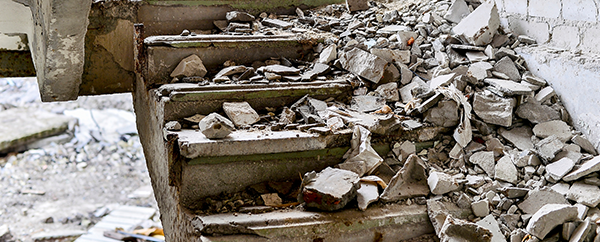24 years after the Northridge earthquake, most homeowners still refuse residential earthquake insurance
This week is the 24th anniversary of the devastating Northridge earthquake, when the 6.7 magnitude temblor struck in the very early morning, killing 60. Two weeks ago, Bay Area residents were awakened by the jarring of a 4.4 quake on the Hayward Fault near UC Berkley. In the last week alone, there have been 136 quakes in California and 12 in the Pacific Northwest. Admittedly, us homeowners don’t like to dwell on it, but we need Arrowhead’s Residential Earthquake Insurance. As a trusted insurance agent, your homeowners depend on you for risk solutions, so here are several reasons why your clients need this coverage.
Because of “blind thrust” faults
At 4:31 a.m. on January 17, 1994 the Northridge earthquake struck, injuring more than 9,000 and destroying thousands of buildings. Apartment complexes crumbled, and freeways collapsed. Gas mains erupted, causing multiple fires that consumed entire blocks, in some cases. Power outages were widespread across the San Fernando Valley and Los Angeles. That quake was caused by the sudden rupture of a previously undocumented “blind thrust fault” (a fault that’s invisible on the Earth’s surface and thus not previously mapped). The quake was the costliest in U.S. history, with 60 deaths and damages of more than $20 billion.
Because faults are continuously being discovered
New fault lines are being discovered every year. Ten months ago, geologists reported that the Newport-Inglewood Fault in Orange County and the Rose Canyon Fault in San Diego are actually one continuous fault, capable of a 7.4 magnitude quake that would impact 20 million residents in Los Angeles and San Diego. A few months prior to that finding, a new fault line was discovered less than 100 miles east of San Diego County under the Salton Sea.
Because it’s not fiscally wise to ignore the risk
Many policyholders don’t know that their regular homeowners policy may not cover any earthquake damage, so they turn a deaf ear when you bring up the subject of residential earthquake insurance. And many who are new to the West Coast have never experienced an earthquake and may therefore be unprepared.
Prior to the Northridge quake, more than 87,000 property owners refused earthquake insurance, saying “I don’t live near the Bay Area, so I’m probably safe.” They were wrong. That previously unknown fault is located nine miles beneath the town of Northridge.
From the Southern California/Mexico border to the tip of Washington, West Coast states encounter earthquake hazards more than any other region in the country. Second only to Alaska in terms of high risk, California has logged hundreds of identified faults, 200 of which are considered potentially hazardous. That’s because more than 70 percent of the state’s population resides within 30 miles of a fault. Annually, California generally gets two or three earthquakes large enough to cause moderate damage to structures (magnitude 5.5 and higher).
Related: 99% Chance of an LA Quake? It’s Time to Talk Coverage Options with Clients
Oregon and Washington lie atop two colliding tectonic plates, causing the Pacific Northwest coastline to bulge upwards. More than a thousand quakes are recorded each year in Oregon, but less than three percent are strong enough to be felt. In Washington, most earthquakes occur west of the Cascades, although some damaging events do occur in the eastern part of the state. Of greater risk for both states is the off-shore earthquake fault system called the Cascadia Subduction Zone. This off-shore fault system is capable of delivering a 9.0 magnitude quake that can create deadly tsunamis, which may last for hours and with increasing intensity.
Because you can provide your homeowners with additional help
As their insurance agent, you can help by providing crucial information such as insuring and securing their homes and possessions, along with tips as to what to do before, during and after a quake.
Related: Help Your Homeowners Prepare for ‘The Big One’
Insurance Information Institute (I.I.I.) has helpful resources that you can share with clients to whom you’re offering residential earthquake insurance. Below are five quick tips and related resources provided by I.I.I. for disaster planning:
- Have a disaster kit on hand with the supplies you need if you must evacuate or manage on your own for a period after a disaster. Your kit should include important documents, enough food and water to last at least 72 hours, and other items necessary for your specific needs such as medications, eyeglasses, catheters, hearing aid batteries or oxygen. For a full list of disaster supply items, see Ready.gov.
- Plan for an evacuation and meeting point for family members.
- Keep an up-to-date file of medical history including doctors, prescriptions and dosages. Include a copy in your disaster kit.
- Keep your homeowners insurance up-to-date. Consumer information related to standard homeowners coverages and how to create a home inventory are available, along with a home inventory template which can be created with I.I.I.’s Know Your Stuff free app for iPhone and Android.
- Take steps to strengthen your home. The Insurance Institute for Business & Home Safety (IBHS) has information about how to make an existing home stronger and safer.
Because you can offer your homeowner clients a number of Arrowhead residential earthquake insurance solutions
With a successful track record for providing earthquake risk solutions since 2000, Arrowhead is one of the leading providers of small business and residential earthquake insurance in the country. We offer highly rated carriers providing stable, long-term earthquake capacity. Some of our earthquake products require no down payment and are 100 percent direct-billed. Some include no age or retrofitting requirements; others include retrofitting credits. All offer broader coverages, higher limits and lower deductibles. The rates are competitive depending on the location of the risk and age of the dwelling.
Learn more about Arrowhead’s Residential Earthquake Program and carriers.
Producer, are you not yet appointed to sell Arrowhead’s Residential Earthquake insurance products? You can get started here.

